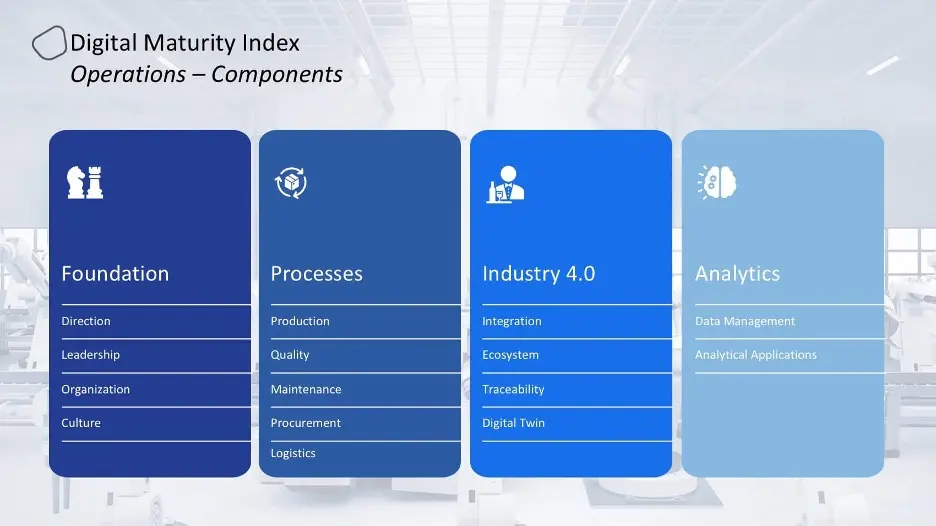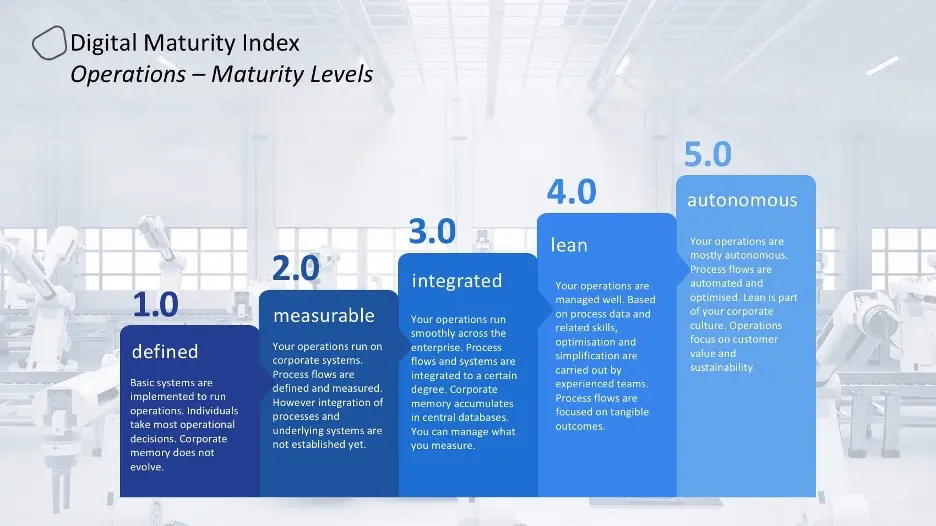
The industrial revolution has brought us our modern civilization. From cars to planes, from fast fashion to foldable furniture, from beach holiday resorts to cat videos – these activities, products, and services rely on one basic assumption: that the underlying operations of production will function like clockwork. And they do…
Industry has continuously improved our quality of life. Industry also continuously improves itself through new inventions, permanent optimization, and persistent quests for better innovation through digital maturity. Ingenious engineering has improved the shop floor, warehouse, logistics, and supply chains.
Especially within the last 60 – 70 years after World War II, the world has applied new technologies, new engineering methods, and better management to all industries. Industry has steadily improved efficiency and the quality of products and services while reducing waste and delay – integrating nearly every aspect of life to become truly global and super-productive.
Today, money flows are fully digitized. Production and transfer of materials are monitored on digital screens across the globe. Various assets are also tracked digitally, and energy is “magically” supplied to industry and household alike through an underlying digital infrastructure that just works. When consumers enter a supermarket or order a t-shirt online, they expect instant gratification, paying no mind to the magic happening in the background. However, the “magic” occurring in the background is what we call operational excellence at its best.

To achieve “operational excellence” an organization must succeed in many components. We have structured them in four main groups: foundation, processes, advanced technologies agenda, and analytics. All of them are equally important, all of them are tightly integrated, and all of them must improve and mature simultaneously.
The Foundation is about strategic capabilities, leadership in place, organisation, and having the necessary skills available to establish an optimized, lean, and agile culture within the organisation.
Every organization has processes. Digital helps to mature each process. Digital integrates them, streamlines them, and makes them seamless and frictionless. Digital enables business processes to become autonomous, light-speed, and effortless. Eventually, all operations will get closer and closer to zero marginal cost.
Another important area of digital maturity is the advanced technologies agenda; let’s call it industry 4.0, retail4.0, or banking 4.0. Emerging trends and technologies are shaping new ways of doing business and delivering value to their stakeholders.
Analytics are ubiquitous. Data is everywhere, and one must make good use of it to make faster and better decisions, forecasts, plans, predictions to prevent malfunction before it happens. All this has become possible due to new technologies, unlimited data, and nearly unlimited processing power.

Every month we discuss one of these dimensions with industry experts and thought leaders, “operational excellence” webinar was specifically within the financial industry. Banks are highly mature when it comes to operations. Banking, money, payments, and financial transfers have been digitally transformed over the last few decades.
Customers expect the best possible experiences and services. The front office must be very attractive, equipped with strategic prices, promotions, user-friendly channels, products, and services. However, even with all of this, if the back office does not function smoothly, or the quality of goods or services don’t match expectations and if deliveries are delayed, customers will be truly and meaningfully disappointed. Additionally, all these delays, deficiencies, and waste produced will result in additional costs. Eliminating these complications streamlines operations, reduces costs, accelerates processes, and delights customers. Eliminating these complications is possible with digital transformation.

Our Digital Maturity Index measures companies on a scale from 1.0 to 5.0. The first maturity level encompasses very basic operations, labeled “defined”. The highest level labeled “autonomous”, describes state-of-the-art operational excellence, with highly automated, integrated, and nearly autonomous company-wide digital capability.
The studies we have conducted in the recent past show that the “operations” dimension is the one that needs the most attention in many companies. For example, if the overall average of digital maturity was measured at 2.7, then the operations dimension averaged at 2.7 as well. There is a lot of room for improvement. We are sure to see huge investments in the area of operations soon, across all industries.
During our work with clients, we have discovered that improving digital maturity in operations is quite difficult. Achieving operational excellence requires a holistic approach, with strong leadership, and synchronized initiatives ranging from the factory shop floor to the warehouse. What exactly is involved in the digital transformation of the operational dimension? This can be anything from supply chain integration to new business models, from new applications to new cultural adaptation, and from refining analytics to determining the quality of operations. Of course, all initiatives are rendered worthless if the foundational operations are already malfunctioning. The Digital Maturity Index can track and analyse it all.
Brief descriptions of each level can be found in the graphic below:

Think of an Old Western film. Amongst the community, there is usually a postal carriage, carrying money, letters, some sort of goods, and couriers. The postal carriage became the trusty post office, and today, that trusty post office has been replaced by global logistics powerhouses, like DHL.
DHL is not only a post office, nor only a logistics service provider. They have become a 3rd party logistics (3PL) and even 4th party logistics (4PL) solution partner for many global enterprises. In addition to handling a logistics workload itself, they mainly handle the technology, planning, integration, and digital aspects of logistics.
We recently measured the digital maturity of one of DHL’s operations, and they scored way above average. Recently they announced that they are prepared to assist in the global distribution of COVID-19 vaccines with all requirements from safety and availability to risk management and cold chain capabilities.
One can easily watch the evolution of the postal industry and understand the power of operational digital transformation on a global scale. Even within this powerful example, there are still many deficiencies and optimization potential across the value chains, in ports, at customs, on the road, and a lot of potential for further optimization. During our lifetime, we will witness the ongoing and never-ending optimization of company operations across all industries, until no human being needs to carry any load. All will happen magically, orchestrated, and operated by digital systems.

Based on our experiences and the best practices we have examined through our work with our Digital Maturity Index, we describe the most advanced level, labeled autonomous.
Imagine a regular, “analog” supply chain. This is operated mostly through a disintegrated ERP system, use of Excel sheets and mail orders, shuffling through paper checklists with manual processes at borders and warehouses.
Now, imagine a fully and tightly integrated supply chain. Fully digital end-to-end processes, blockchain secured information, material, financials, and data flows with end-to-end traceability. Which one would you prefer? Which one do you think is more effective, productive, sustainable, and profitable? The choice for the 21st century is clear.
So, why do you hesitate to invest in digital transformation? You know the benefits, what is stopping you from justifying the effort? Our services can help you in measuring your current maturity, setting targets for the future, defining strategies, and plotting your roadmap to digital greatness. Don’t wait to ignite your digital journey.
Check out the rest of the articles in our Digital Maturity Explained series and learn more about all the dimensions of Digitopia’s Digital Maturity Index.
Digital Maturity Explained: All About Business Performance
Digital Maturity Explained: Governance, Reimagined
Digital Maturity Explained: Operations, Rebooted
Digital Maturity Explained: Technology, Reset
Digital Maturity Explained: Innovation, Reignited

